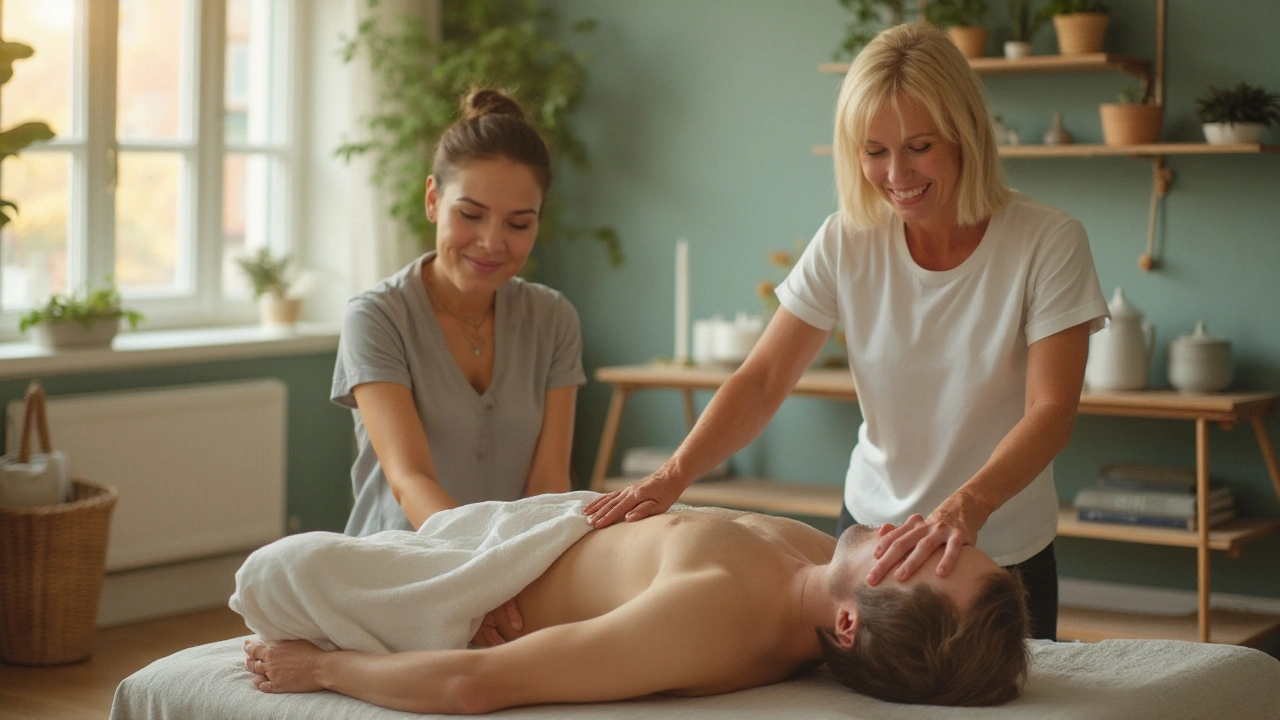Chronic pain affects many people, turning simple tasks into daunting challenges. Traditional treatments sometimes fall short, leaving those afflicted searching for alternatives that offer genuine relief. Rolfing, a unique form of bodywork therapy, steps into this gap with its approach to structural realignment.
Originating from the insights of Dr. Ida Rolf, Rolfing is more than mere massage; it delves into the body's complex network of connective tissues. By guiding the body into better alignment, Rolfing addresses not just the symptoms but the sources of chronic pain.
Individuals who have engaged in Rolfing often speak of enhanced flexibility, reduced pain, and a newfound awareness of their bodies. This method focuses on understanding how lifestyle and posture affect our musculoskeletal health. With each session, Rolfing works to gently coax the body toward its natural, harmonious state.
- Understanding Rolfing and Its Origins
- How Rolfing Targets Chronic Pain
- The Science Behind Body Alignment
- Practical Tips for Considering Rolfing Therapy
Understanding Rolfing and Its Origins
The story of Rolfing begins with a visionary approach to healing that diverged from the conventional paradigms of its time. Developed by American biochemist Dr. Ida P. Rolf in the mid-20th century, Rolfing found its roots in her deep fascination with body structure and its impact on physical health. Dr. Rolf believed that the human body, like any structure, could be realigned and balanced, resulting in profound pain relief and improved function. Her investigations led her to conclude that many physical ailments were due to misalignment in the body's fascia, a web of connective tissue that encases muscles and organs. This discovery formed the basis of Rolfing, which she termed Structural Integration.
Dr. Rolf's innovative methods challenged prevailing medical wisdom, earning both acclaim and skepticism. Rolfing sessions often resemble deep tissue work but are distinct in their intensity and focus on systematic realignment. According to her research, a body in alignment with the earth’s gravitational field functions more harmoniously and efficiently, possibly easing issues like chronic pain. Dr. Rolf's pioneering work gained a devoted following, leading to the establishment of the Rolf Institute in 1971, dedicated to educating practitioners in her methods.
"When the body gets working appropriately, the force of gravity can flow through. Then, spontaneously, the body heals itself," Dr. Rolf famously stated, encapsulating the philosophy behind this bodywork approach.
Being deeply tied to the layers of connective tissue, Rolfing focuses on the reorganization of the fascia to release restrictions and patterns that inhibit optimal body mechanics. Each Rolfing session addresses a specific aspect of bodily alignment, progressively working to balance from head to toe. The therapy often follows 'the Ten Series,' a sequence designed to systematically address the whole body over ten sessions.
Today, Rolfing is practiced worldwide, revered for its transformative effects on individuals suffering from chronic pain. Its principles have been embraced by athletes, dancers, and anyone looking to enhance their physical well-being. This unique blend of art and science ensures Rolfing remains a compelling option for those in search of non-invasive, long-lasting methods of pain management and holistic healing.
The legacy of Dr. Rolf continues to thrive as modern practitioners build upon her foundations, integrating new insights into this discipline. Rolfing's lasting appeal lies in its capacity to blend intuitive touch with scientifically grounded techniques, persisting as a beacon of hope for those caught in the grip of persistent pain.

How Rolfing Targets Chronic Pain
Chronic pain can weave itself into daily life, leaving many searching for ways to untangle its grip. Rolfing offers a distinctive approach by addressing the foundational aspects of how the body holds and distributes tension. Unlike traditional methods that focus on the symptomatic relief of pain, Rolfing dives deep into the body's intricate architecture, considering how structural misalignments contribute to persistent discomfort. By aiming to align the body's connective tissues, known as fascia, practitioners work to redistribute strain and bring back lost harmony.
The concept here is that our bodies tend to follow certain patterns developed over years of habits, injuries, and emotional stress. These patterns often lead to chronic pain due to imbalances in our bodily structure. During a Rolfing session, a certified Rolfer carefully manipulates these soft tissues, inviting the body to let go of these habitual patterns. This interaction doesn't just temporarily ease muscles; it helps reset the body's alignment, paving the way for profound and lasting change.
One fascinating aspect of Rolfing is its holistic consideration of the human posture as a dynamic process rather than a static framework. This means that in achieving pain relief, it’s not merely about changing how we sit or stand, but how we move and live. In fact, a study published in the "Journal of Bodywork and Movement Therapies" noted significant improvements in participants’ joint mobility and pain levels after undergoing Rolfing sessions. This highlights the functional improvements that can manifest as practitioners peel away layers of tension.
"Rolfing is not about fixing the body, but about giving it the tools to heal itself through realignment," says Thomas Meyers, a well-respected figure in the field of structural bodywork.
As the process unfolds, each session typically builds upon the previous one, helping individuals uncover and relieve long-buried tension. It’s not uncommon for deep-rooted emotions to surface during the therapy as the body sheds old burdens, offering a psychological dimension to the physical benefits. This emotional release can be transformative, further underscoring how interconnected our physical and mental states are.
To enhance these effects and make them last, clients are often encouraged to maintain awareness of the newfound alignments beyond the sessions. Practicing mindfulness and engaging in complementary exercises like yoga or tai chi can strengthen the benefits experienced. With time, many find that regular Rolfing sessions coupled with these mindful practices make a potent combination for managing chronic pain effectively.

The Science Behind Body Alignment
Our bodies are complex systems of bones, muscles, and connective tissues that work harmoniously in a properly aligned state. Misalignment, often resulting from prolonged poor posture or injury, disrupts this harmony, leading to muscle tension and chronic pain. Rolfing aims to address these issues at their root by focusing on structural integration. By realigning the body's tissues, this therapy enhances its natural movement and functionality.
Dr. Ida Rolf, the pioneer of this technique, believed that realigning the body's fascia — the connective tissue that wraps around muscles and organs — was key to resolving pain. She hypothesized that gravity, when the body is aligned correctly, can actually become a supportive force in how we function daily. The science of Rolfing suggests that when the fascia is manipulated, muscle tension decreases, allowing the body to restore its optimal alignment naturally.
Fascia plays a crucial role in maintaining body structure, and modern science supports Dr. Rolf's theories. Research indicates that fascial tissues, when neglected, can lose flexibility, contributing to chronic pain and decreased mobility. By manipulating this tissue, Rolfing promotes elasticity, easing movement. Supporters of Rolfing often report increased range of motion and reduced pain levels after just a few sessions.
A recent study published in the Journal of Bodywork and Movement Therapies notes, "Rolfing has demonstrated positive outcomes in reducing musculoskeletal pain and improving physical performance." This intuitive quote captures the essence of Rolfing's impact on those living with pain.
Scientific studies have also delved into the neurological effects of body alignment. When alignment is corrected, pressure on nerves along the spinal column is relieved, which can significantly impact pain perception and stress distribution throughout the body. In essence, a body that moves with ease experiences less strain, reducing pain stimuli at their origin.
Implementing techniques from bodywork therapy like Rolfing requires skilled therapists who understand the body's biomechanics. By analyzing individual body patterns and tailor-making each session, Rolfing can subtly yet effectively readjust the fascia. Maintaining body alignment involves lifestyle adjustments, too, like paying attention to posture during everyday tasks and incorporating gentle stretches to reinforce the changes brought on by Rolfing sessions.

Practical Tips for Considering Rolfing Therapy
Exploring Rolfing as a potential solution for chronic pain can be a transformative decision. However, like any therapeutic journey, there are considerations to keep in mind to maximize benefits and ensure it aligns with your needs. To begin, it's helpful to understand your body's specific pain points and restrictions. Taking time to assess where you feel tension or discomfort can guide your conversations with a Rolfer, ensuring they tailor their approach to your unique concerns. Since Rolfing emphasizes structural integration, knowing your body's history, including past injuries or surgeries, provides valuable context for your practitioner. This preparatory step bridges your personal experience with Rolfing's holistic philosophy.
Another key tip is to research qualified Rolfers in your area. Finding a certified practitioner who resonates with you is crucial for a successful experience. The Rolf Institute of Structural Integration is a reputable organization providing certification, ensuring standard practice and technique. Engaging with a professional who listens and communicates well can significantly impact your comfort and outcomes. It may be beneficial to schedule a consultation or attend workshops to gauge if Rolfing meets your expectations. During this preliminary meeting, inquire about their experience with chronic pain relief and their approach to handling it.
Scheduling logistics also matter. Rolfing typically involves multiple sessions, often between 10 to 12, forming a cycle known as the ‘Ten Series.’ This systematic sequence allows practitioners to address intricacies within the body progressively. Many individuals notice changes after just one session, but long-lasting results often develop over time. Consistency is key, and being mindful of session frequency helps build momentum in your healing journey. Aligning sessions with your daily routine will improve adherence, preventing cancellations or delays that could disrupt your progress.
Financial considerations should not be overlooked. Costs may vary by region and practitioner expertise, so it's wise to discuss fees upfront. Some insurance plans might offer partial reimbursement under specific conditions. If cost constitutes a hurdle, budget planning or exploring payment plans with your Rolfer might provide feasible options. Remember that Rolfing is an investment in your long-term health and well-being, potentially offering benefits that far outweigh initial expenses.
"Rolfing taps into the body's innate ability to heal itself, offering an option beyond conventional medical approaches," says Dr. Christine Lasmar, an expert in integrative medicine.
A final note to ensure success is setting realistic expectations and open-mindedness. While many report significant relief, experiences vary, and change might be subtle and gradual. Preparing mentally and physically for this journey embraces the depth of the transformation process. Keeping a journal of changes, sensations, and emotional shifts post-session can be insightful, offering a comprehensive view of the therapy's impact over time. This ongoing reflection can be a powerful motivator to see the cycle through, appreciating the finer enhancements in your body's alignment and function.


 Health and Wellness
Health and Wellness